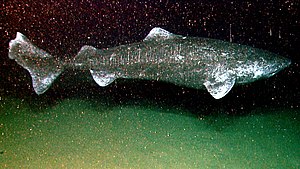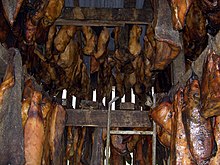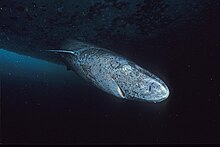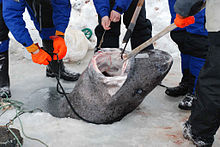Greenland shark
| Greenland shark | ||||||||||||
|---|---|---|---|---|---|---|---|---|---|---|---|---|

Greenland Shark ( Somniosus microcephalus ) |
||||||||||||
| Systematics | ||||||||||||
|
||||||||||||
| Scientific name | ||||||||||||
| Somniosus microcephalus | ||||||||||||
| ( Bloch & Schneider , 1801) |
The Greenland Shark or Ice Shark ( Somniosus microcephalus ) is a shark from the order of the dogfish-like (Squaliformes). Little is known about the species so far. Investigations from 2016 showed that Greenland Sharks can live to be a few hundred years and thus reach the highest age of all vertebrate species.
anatomy
The Greenland Shark averages 4 to 5 meters long, but larger specimens can reach almost 8 meters in length and weigh up to 2.5 tons. Its body is torpedo-shaped, its coloration is gray-brown to olive-green. The fins are relatively small, they have no thorns and the caudal fin is asymmetrical.
distribution
The Greenland Shark lives mostly in cold areas. The range of this species are the arctic waters of the North Atlantic . Occasionally it is also found further south, as far as the Bay of Biscay . This shark can dive up to 2,000 meters deep. In 1995, an unmanned submarine filmed a 6-meter-long Greenland shark at the wreck of the Central America off the coast of South Carolina at a depth of 2200 meters - more than 1000 meters below the previously observed diving depth. It was also the southernmost sighting of a Greenland Shark to date.
Way of life
The Greenland Shark is still little explored. Nothing is known about its endangerment, but since the animals repeatedly unintentionally go into the nets, they can be considered endangered. The first film recordings of living specimens were made by US researchers in 1998. A scientific working group led by Nigel E. Hussey (2014) examined these sharks in Baffin Bay . A copy has been provided with a transmitter to document its hiking trails and diving depths.
nutrition
Earlier research assumed that the shark lived only in the direct vicinity of the sea bed at depths of several hundred meters and looked for food (especially sinking carrion) while swimming lazily.
According to recent findings, however, it appears to feed mainly on seals and fish and to actively hunt them at both great and shallow depths. These investigations include long-term position determinations of the Greenland Sharks with the use of direction finders. It is believed that despite its slow locomotion, the Greenland Shark can prey on seals because it attacks them while they sleep. The discovery of a jawbone of a (not yet fully grown) polar bear in the stomach of a Greenland shark at least suggests that this shark is able to overpower even larger prey.
The bioluminescent copepods Ommatokoita elongata often sit on the eyes of this species of shark . It is not known whether they harm or benefit the shark. There are explanations for both possibilities: One theory says that they paralyze the eyes, and they even blind the sharks. Another theory assumes that copepods luminesce, attract the attention of other animals and use it to "bait" food for the sharks.
Reproduction and development
The Greenland Shark is ovoviviparous ('egg-giving birth'), which means that the young hatch from the eggs in the womb and are then born. Newborn bowhead sharks are approximately 40 cm in length. The time of sexual maturity was estimated to be at least 150 years. At this point the sharks have reached a length of around 4 meters.
Due to their very slow growth and the considerable size they can still achieve, it has long been suspected that bowhead sharks can reach a very old age. The average growth rate is initially maximal and decreases over time. In the second half of the natural lifespan, the growth rate is significantly less than 1 cm body length annually.
A more precise age determination was published in 2016 by a research team headed by the University of Copenhagen . Using radiocarbon analysis, the researchers analyzed the lenses of 28 female Greenland Sharks, 81 to 502 cm in length, that were caught between 2010 and 2013. The eye lens was chosen because the nucleus of the eye lens is already formed in the embryonic stage and is composed of crystalline proteins that are no longer subject to metabolism after the embryonic stage, i.e. H. no longer be re-formed. The core of the eye lens therefore forms a kind of biological " time capsule " from the time of birth. Of the 28 Greenland Sharks analyzed, only the two smallest specimens found traces of the atmospheric nuclear tests from the 1950s, which significantly increased the 14 C content of the entire biosphere and which can be detected as a nuclear weapon effect or so-called “bomb pulse” during radiocarbon dating . Most of the sharks examined had to be born before the early 1960s, ie at least around 50 to 60 years old. Based on this dating, a 220 cm long specimen could be assigned an age of around 50 years. The largest specimen examined, 5.02 meters long, was estimated to be 392 ± 120 years old. The Greenland Shark is thus the vertebrate with the longest known lifespan.
The lifespan exceeds that of the also very long-lived bowhead whale (documented a little over 200 years), the killer whale (over 100 years) and the emperor perch ( Hoplostethus atlanticus , estimated around 150 years). In this respect, the Greenland Shark is surpassed in the animal world by the Icelandic mussel (measured 507 years) and the giant Antarctic sponge Anoxycalyx joubini (assumed over 10,000 years).
Enemies
Suspected predators of the Greenland Shark are sperm whales and orcas . The latter are believed to be dangerous to the Pacific Sleeper Shark , a close relative of the Greenland Shark .
Systematics
The Greenland Shark is classified as an independent species in the genus Somniosus within the Sleeping Sharks (Somniosidae), which includes five other species. The first scientific description comes from Marcus Élieser Bloch and Johann Gottlob Theaenus Schneider from 1801 in the Systema Ichthyologiae iconibus ex illustratum developed by Bloch and revised by Schneider and published after Bloch's death .
Greenland shark and human
Conduct towards people
There are no known attacks on humans by bowhead sharks. Greenland sharks were considered lazy at the time they were named - the Latin name Somniosus means "the sleepy one". The Inuit report that this species of shark is able to attack a kayak. Given its size, the ice shark would be able to be dangerous to humans. However, in the polar waters with their extreme water temperatures, encounters between Greenland Sharks and humans are extremely rare. In 1859 a Greenland Shark was caught around Pond Inlet with a half-digested human leg in its stomach.
Importance to fishing

The meat of the Greenland Shark cannot be eaten without special preparation. It contains trimethylamine oxide , which is broken down into trimethylamine during digestion , which can be harmful to health. Researchers warn against fishing for the Greenland Shark or uncritically accepting that it will be caught as bycatch in arctic waters as long as there are no precise data on its distribution. A living being with such a long lifespan presumably also has an extremely low reproductive rate.
It is of little interest for sport fishing , as caught animals are usually marked and released. You can only utilize your large liver, skin and fins. In Greenland and Iceland , its dried meat is used as dog food; In addition, the fermented meat ( Hákarl ) is considered a special, strong-tasting delicacy among Icelandic gourmets .
Danger
The International Union for Conservation of Nature (IUCN) lists the species in its Red List of Endangered Species as a type of warning list ("Near Threatened"). This species is considered an extremely long-lived and slow-growing shark with limited reproductive capabilities.
In Norway, Iceland, and Greenland, about 32,000 sharks were caught per year in Greenland alone in the 1910s. This fishery may have had a significant impact on this species, but the rate of historical decline is unknown. The Greenland Shark is currently caught as bycatch in trawl, gillnet and trap fisheries, as well as in private fisheries in the Arctic. The population dynamics and biology of the species are only understood to a limited extent. This shark is classified as Suspected Endangered based on possible population declines. However, there is a need to study historical data and monitor current bycatch levels.
Trivia
- In jurisprudence , a famous German legal battle, the Haakjöringsköd case , is named after the Greenland Shark.
- In the novel Das Buch vom Meer or How two friends take off in a rubber dinghy to catch an ice shark in the North Sea, and it takes a whole year for that by Norwegian journalist, photographer and writer Morten A. Strøksnes , the greenland shark plays a key role.
supporting documents
- ↑ a b c d Julius Nielsen et al .: Eye lens radiocarbon reveals centuries of longevity in the Greenland shark (Somniosus microcephalus) . In: Science . tape 353 , no. 6300 , August 12, 2016, p. 702-704 , doi : 10.1126 / science.aaf1703 .
- ↑ TBT: That time a shark we'd never heard of made a deep-sea cameo | Sharks | Earth Touch News. Retrieved August 3, 2020 .
- ↑ Charles E. stove Village, Tim M. Berra: A Greenland Shark from the Wreck of the SS Central America at 2,200 meters . In: Transactions of the American Fisheries Society . tape 124 , no. 6 , 1995, pp. 950-953 , doi : 10.1577 / 1548-8659 (1995) 124 <0950: AGSFTW> 2.3.CO; 2 .
- ↑ Alina Schadwinkel: Eishai: This shark is 400 years old . In: The time . 11th August 2016.
- ^ Nigel E. Hussey et al .: Juvenile Greenland sharks Somniosus microcephalus (Bloch & Schneider, 1801) in the Canadian Arctic . In: Polar Biology . tape 38 , no. 4 , 2015, p. 493-504 , doi : 10.1007 / s00300-014-1610-y ( PDF ).
- ↑ K. Yano, JD Stevens, LJV Compagno: Distribution, reproduction and feeding of the Greenland shark Somniosus (Somniosus) microcephalus, with notes on two other sleeper sharks, Somniosus (Somniosus) pacificus and Somniosus (Somniosus) antarcticus . In: Journal of Fish Biology . tape 70 , no. 2 , February 2, 2007, p. 374-390 , doi : 10.1111 / j.1095-8649.2007.01308.x .
- ↑ Greenland Shark: How the Slowest Fish Catches Seals , on Spiegel.de from June 27, 2012; accessed on August 12, 2016.
- ↑ Clash of the fiercest predators as shark eats polar bear. www.independent.co.uk, August 12, 2008.
- ↑ marinespecies.org: Ommatokoita elongata
- ↑ The time span of ± 120 years corresponds to twice the standard deviation .
- ↑ John C. George et al .: Age and growth estimates of bowhead whales (Balaena mysticetus) via aspartic acid racemization . In: Canadian Journal of Zoology . tape 77 , no. 4 , 1999, p. 571-580 , doi : 10.1139 / z99-015 .
- ^ A b Longevity Secrets from the Five Longest-Lived Marine Animals. oceana.org, December 18, 2015, accessed on August 15, 2016 .
- ^ Paul G. Butler et al .: Variability of marine climate on the North Icelandic Shelf in a 1357-year proxy archive based on growth increments in the bivalve Arctica islandica . In: Palaeogeography, Palaeoclimatology, Palaeoecology . tape 373 , March 1, 2013, p. 141–151 , doi : 10.1016 / j.palaeo.2012.01.016 .
- ^ "Greenland Shark / Requin du Groenland." Accessed August 12, 2016.
- ↑ FLMNH, Ichtyology at the Florida's Museum of Natural History, Greenland Shark
- ↑ a b Somniosus microcephalus in the endangered Red List species the IUCN 2006 Posted by: PM Kyne, SA Sherrill-Mix, GH Burgess, 2005. Accessed July 13, 2020th
literature
- GB Skomal, GW Benz: Ultrasonic tracking of Greenland sharks, Somniosus microcephalus, under Arctic ice . In: Marine Biology . tape 145 , no. 3 , March 2004, p. 489-498 , doi : 10.1007 / s00227-004-1332-8 .
- LB Hulbert, MF Sigler, CR Lunsford: Depth and movement behavior of the Pacific sleeper shark in the north-east Pacific Ocean . In: Journal of Fish Biology . tape 69 , no. 2 , August 2006, p. 406-425 , doi : 10.1111 / j.1095-8649.2006.01175.x .
Web links
- Greenland Shark on Fishbase.org (English)
- Somniosus microcephalus in the endangered Red List species the IUCN 2006 Posted by: PM Kyne, SA Sherrill-Mix, GH Burgess, 2005. Accessed July 13, 2020th
- "Eishaie: Hunters in the Cold" , SPON , March 26, 2007, picture series
- "The Greenland Shark and Elasmobranch Research Group"
- "Franz Josef Land: extreme northern outpost for Arctic fishes"
- "Watch: Video of Rare Deep-Sea Shark Blows Researcher's Mind"
- Calm down, scientists didn't discover a 512-year-old shark. Media criticism in the Washington Post (English)




